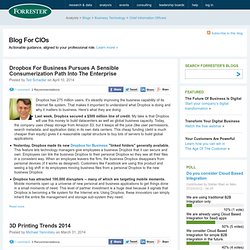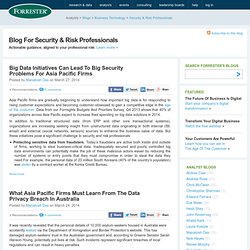

Enterprise. Infrastructure & Operations Professionals - Forrester Blog. March Madness – Five Years Ago It was five years ago, March 2009, when Cisco formally announced “Project California,” its (possibly intentionally) worst-kept secret, as Cisco Unified Computing System.

At the time, I was working at Hewlett Packard, and our collective feelings as we realized that Cisco really did intend to challenge us in the server market were a mixed bag. Some of us were amused at their presumption, others were concerned that there might be something there, since we had odd bits and pieces of intelligence about the former Nuova, the Cisco spin-out/spin-in that developed UCS. Most of us were convinced that they would have trouble running a server business at margins we knew would be substantially lower than their margins in their core switch business. Fast Forward Five years later, HP is still number one in blade server units and revenue, but Cisco appears to be now number two in blades, and closing in on number three world-wide in server sales as well.
Lessons Learned. Novelguide.com. The SharePoint Hillbilly. Application Development & Program Management Professionals - Forrester Blog. State-owned enterprises (SOEs) in China face a quickly changing competitive landscape — one that their existing technology strategies can’t keep up with.

To address this challenge, organizations are migrating from earlier-generation BI architectures, technologies, and organizational structures to new models and approaches. My “Chinese State-Owned Enterprise Targets Improved Agility” report, scheduled to appear later this month, describes the experience of a typical large Chinese SOE, the China National Cereals, Oils, and Foodstuffs Corporation (COFCO), which leveraged a BI-led program to jump-start the transformation of its technology management capabilities. Business Process & Applications Professionals - Forrester Blog. In developing a technology strategy for your organization, what will be your basis for deciding which technologies to pursue, when to pursue them, and how to implement them?

In other words, what will be the foundation for your technology architecture and strategy? In considering this question, I assume we agree that technology strategy should directly support improvement of business outcomes, both now and over the long haul. To provide for the long haul, your technology architecture and strategy must be crafted to support a continuous stream of business change, both small incremental steps and large radical shifts. Your strategy could begin with a list of hot technologies — perhaps even ones that business colleagues are clamoring for — but how would you know which of them would lead to the most important improvements in business outcomes? The Forrester Blog For CIOs. Today Microsoft starts shipping Office for iPad, finally plugging the gap in its portfolio that’s been filled by popular document viewers and editors like QuickOffice and SlideShark.

Does this come too late for Microsoft? As much as naysayers like to proclaim Office is dying, people still overwhelmingly use it at home and at work. Office is supported at virtually every organization. Our survey of Forrester clients at the end of last year showed strong strides by Google Docs with 13% of firms using it.* However, the caveat is companies that have gone Google are using Docs to complement Office with collaboration features and mobile support, not to replace it.
You could argue how much incremental revenue Microsoft lost out on, but I don’t think the lack of native Office apps has caused Microsoft to cede ground to other office productivity suites on the PC, where the vast majority of content is still created. Is Microsoft really multi-platform now? Security & Risk Professionals - Forrester Blog. The information security profession is built on three fundamental tenets, those of confidentiality, availability, and integrity.

Increasingly, however, I see two things happening: - Organizations are reprioritising these to reflect their significance within their organization, with confidentiality often trailing to availability and integrity; or - Additional aspects such as authentication, authorization, non-repudiation etc. are supplementing the CIA triad. It seems that there may be a growing group of S&R professionals who are dissatisfied with these concepts, feeling that they are ambiguous or incomplete, and some find it troublesome that they lack standard units of measurement.
It was with interest, therefore, that I noted a competition issued by the O-ISM3 Consortium, an organization that focuses on fostering alignment between security objectives and business goals.